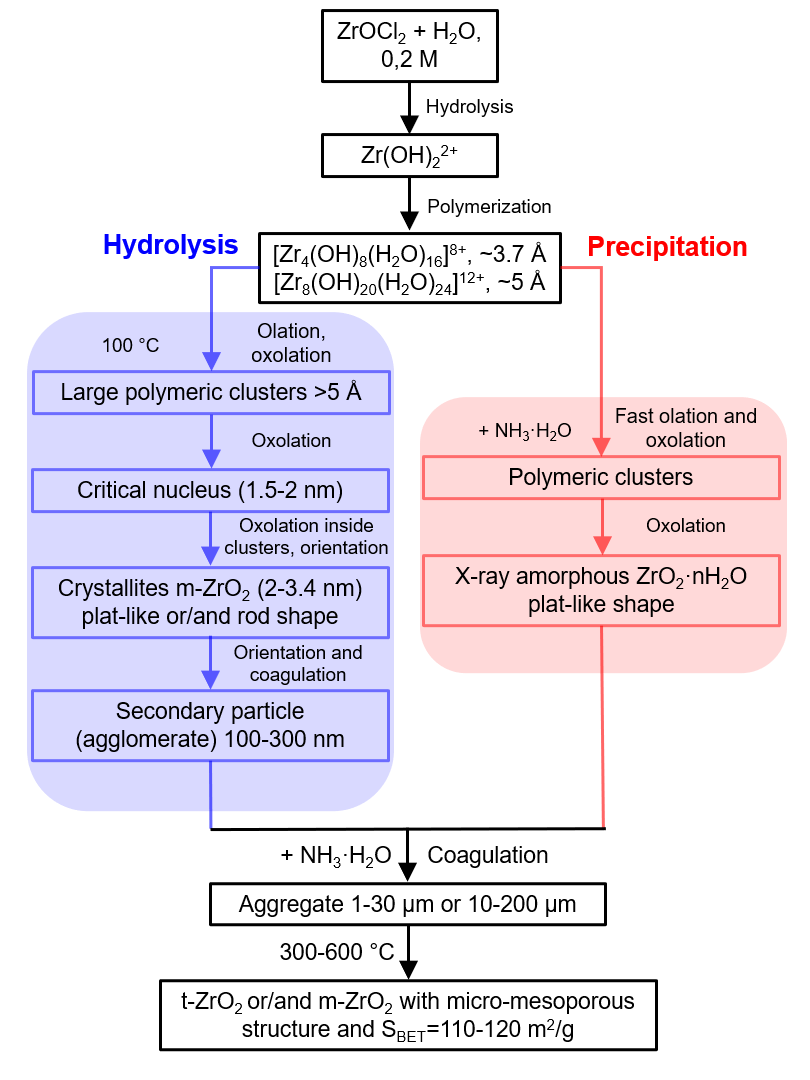NANOSYSTEMS: PHYSICS, CHEMISTRY, MATHEMATICS, 2021, 12 (4), P. 472–480
The effect of hydrolysis duration on the phase composition, texture, aggregation and agglomeration of ZrO2 nanoparticles
Sh. O. Omarov – Ioffe Institute, Saint Petersburg, 194021, Russia; somarov@mail.ioffe.ru
In this work, a number of ZrO2·nH2O and ZrO2 samples were synthesized by direct precipitation and hydrolysis with different duration (36 and 61 h) followed by neutralization and thermal treatment. The prepared samples were analyzed using DT-TGA, PXRD, N2 physisorption and LD methods. The dependence of the size of crystallites and secondary particles, phase composition, texture, and particle morphology on the amount of zirconium hydrolyzed to form m-ZrO2 is shown. The possibility of regulating the phase composition of ZrO2 has been established while maintaining the specific surface area (110 – 120 m2/g), as well as creating a hierarchical system of micro-mesopores. The mechanism of the ZrO2·nH2O formation during hydrolysis and precipitation is considered. The size of the critical nucleus is estimated (1.5 – 2 nm).
Keywords: zirconia, hydrolysis, phase composition, texture, aggregation, agglomeration, mechanism.
PACS 81.20.-n, 61.46.+w, 81.10.-h, 64.70K
DOI 10.17586/2220-8054-2021-12-4-472-480
[In Russian] Ш. О. Омаров
Влияние продолжительности гидролиза на фазовый состав, текстуру, агрегацию и агломерацию наночастиц ZrO2
В работе ряд образцов ZrO2·nH2O и ZrO2 синтезирован прямым осаждением и гидролизом различной продолжительности (36 и 61 ч) с последующей нейтрализацией и термической обработкой. Подготовленные образцы были проанализированы с использованием методов DT-TGA, PXRD, физической сорбции N2 и метода LD. Показана зависимость размеров кристаллитов и вторичных частиц, фазового состава, текстуры и морфологии частиц от количества циркония, гидролизующегося с образованием m-ZrO2 . Установлена возможность регулирования фазового состава ZrO2 при сохранении удельной поверхности (110‒120 м2/г), а также создание иерархической системы микромезопор. Рассмотрен механизм образования ZrO2·nH2O при гидролизе и осаждении. Оценен размер критического зародыша (1.5 – 2 нм).
Ключевые слова: диоксид циркония, гидролиз, фазовый состав, текстура, агрегация, агломерация, механизм.
